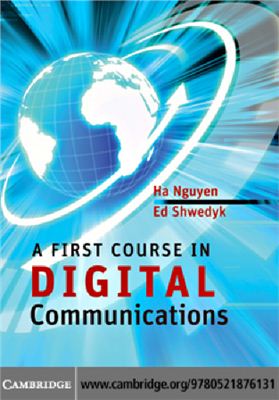Издательство Cambridge University Press, 2009, -564 pp.
As the title indicates, the text is intended for persons who are undertaking a study of digital communications for the first time. Though it can be used for self-study the orientation is towards the classroom for students at the fourth-year (senior) level. The text can also serve readily for a beginning-level graduate course. The basic background assumed of the reader is: (i) introductory linear circuit and systems concepts, (ii) basic signal theory and analysis, and (iii) elementary probability concepts. Though most undergraduate electrical and computer engineering students have this background by their final year, the text does include two review chapters which the reader is strongly encouraged to read.
By reading these chapters she/he will obtain a sense of the authors’ pedagogical style and the notation used. The notation used is quite standard except (perhaps) in the case of random variables or events. They are denoted (faithfully and slavishly) by boldface. As importantly, because of their importance in digital communications, several topics that may or may not be covered in typical introductory courses, are explained in detail in these chapters. The primary topic is random signals which, after a treatment of random variables and probability concepts, are explained in the necessary depth in Chapter
3. Another topic of importance that typically is not touched on or is treated in only a cursory fashion in an introductory signal course is auto- and crosscorrelation and the corresponding energy and power spectral densities. These are explained in Chapter 2 for deterministic signals and Chapter 3 for random processes.
The text material is a reflection of many years (over two decades for the second author) of teaching digital (and analog) communications at the undergraduate level at three universities. At all three universities the course was one term or semester in duration with approximately 36 hours of lectures. The students had diverse backgrounds: at one university they had a prerequisite course where analog communications and random processes were covered, at the second university the students had no background in random concepts even at the elementary level. In both universities the students were in a quite general electrical and engineering program. The third university was one where the students specialized in telecommunications. Except perhaps for the material in the advanced modulation chapter (Chapter 11), the text material can be quite comfortably covered in the allotted time.
Introduction
Deterministic signal characterization and analysis.
Probability theory, random variables and random processes.
Sampling and quantization.
Optimum receiver for binary data transmission.
Baseband data transmission.
Basic digital passband modulation.
An alteative representation of QPSK.
M-ary signaling techniques.
Signaling over bandlimited channels.
Signaling over fading channels.
Advanced modulation techniques.
Synchronization.
As the title indicates, the text is intended for persons who are undertaking a study of digital communications for the first time. Though it can be used for self-study the orientation is towards the classroom for students at the fourth-year (senior) level. The text can also serve readily for a beginning-level graduate course. The basic background assumed of the reader is: (i) introductory linear circuit and systems concepts, (ii) basic signal theory and analysis, and (iii) elementary probability concepts. Though most undergraduate electrical and computer engineering students have this background by their final year, the text does include two review chapters which the reader is strongly encouraged to read.
By reading these chapters she/he will obtain a sense of the authors’ pedagogical style and the notation used. The notation used is quite standard except (perhaps) in the case of random variables or events. They are denoted (faithfully and slavishly) by boldface. As importantly, because of their importance in digital communications, several topics that may or may not be covered in typical introductory courses, are explained in detail in these chapters. The primary topic is random signals which, after a treatment of random variables and probability concepts, are explained in the necessary depth in Chapter
3. Another topic of importance that typically is not touched on or is treated in only a cursory fashion in an introductory signal course is auto- and crosscorrelation and the corresponding energy and power spectral densities. These are explained in Chapter 2 for deterministic signals and Chapter 3 for random processes.
The text material is a reflection of many years (over two decades for the second author) of teaching digital (and analog) communications at the undergraduate level at three universities. At all three universities the course was one term or semester in duration with approximately 36 hours of lectures. The students had diverse backgrounds: at one university they had a prerequisite course where analog communications and random processes were covered, at the second university the students had no background in random concepts even at the elementary level. In both universities the students were in a quite general electrical and engineering program. The third university was one where the students specialized in telecommunications. Except perhaps for the material in the advanced modulation chapter (Chapter 11), the text material can be quite comfortably covered in the allotted time.
Introduction
Deterministic signal characterization and analysis.
Probability theory, random variables and random processes.
Sampling and quantization.
Optimum receiver for binary data transmission.
Baseband data transmission.
Basic digital passband modulation.
An alteative representation of QPSK.
M-ary signaling techniques.
Signaling over bandlimited channels.
Signaling over fading channels.
Advanced modulation techniques.
Synchronization.

